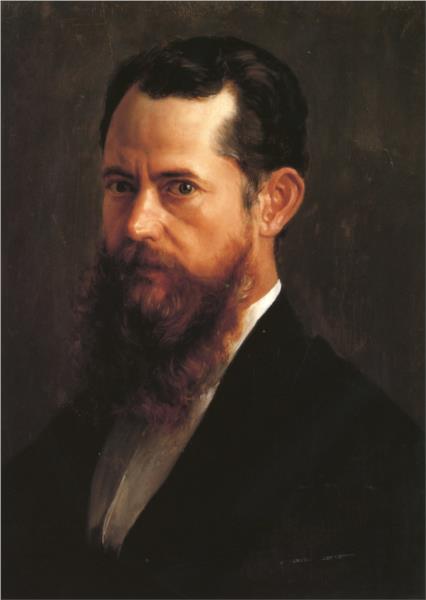Description
In the nineteenth -century Mexican art scenario, the self -portrait of José María Velasco, made in 1877, is presented as an essential work that reveals not only its technical mastery, but also a deep personal introspection. This painting, which shows the artist in a direct and contemplative pose, is erected as a testimony not only of his skill in the representation of the human being, but also of his ability to convey emotions through the image.
The composition of this self -portrait is a balanced exercise of shapes and colors, in which the artist is in the center of the work, looking straight ahead. The background, which presents a dark and neutral hue, gives a significant contrast with the illuminated face of Velasco, simulating a zenith light that accentuates its features. The use of subtle shadows on his face suggests a meticulous study of chiaroscuro, a technique that Velasco dominated throughout his career. The painter's gaze is intense, as if inviting the viewer to enter his thoughts and reflections, while his slight smile seems to hint a quiet confidence before the viewer.
The color plays a crucial role in the visual narrative of this work. Velasco uses a palette of warm tones that cover different nuances of brown and beige, along with accents in lighter tones that draw the texture of their skin and hair. This color treatment not only gives the work of a sensation of volume and depth, but also adds a human warmth that resonates with the essence of its portrait. This use of color is characteristic of Velasco, who is widely known for its landscapes and its meticulous attention to the details that evoke Mexican nature.
It is interesting to note that, although the human figure is the focus of this self -portrait, the work remains a reflection of the broader style of the painter, who was an outstanding representative of the romantic landscape. Through his career, Velasco developed a personal style in which the influence of naturalism and romanticism intertwined, allowing him to explore not only the environment that surrounded him, but also his own place in him. The self -portrait, in this case, becomes a bridge between his identity as an artist and his cultural context.
Velasco, born in a time of great transformations in Mexico, managed to channel his environment in his works and this self -portrait is no exception. By representing himself, he also becomes a bearer of national identity, reflecting the values and aesthetics that characterized his time. This aspect of his work is significant, since the self -portrait can be seen as a claim of his role as a creator and witness of his time.
Together, the 1877 self -portrait of José María Velasco is a work that transcends simple physical representation. It is a reflection of his search for authenticity and artistic ambition. Through the masterful use of light, color and composition, Velasco invites us to look beyond the surface, suggesting an emotional depth that continues to resonate today, reaffirming its place as one of the great masters of Mexican art.
KUADROS ©, a famous paint on your wall.
Hand-made oil painting reproductions, with the quality of professional artists and the distinctive seal of KUADROS ©.
Art reproduction service with satisfaction guarantee. If you are not completely satisfied with the replica of your painting, we refund your money 100%.

